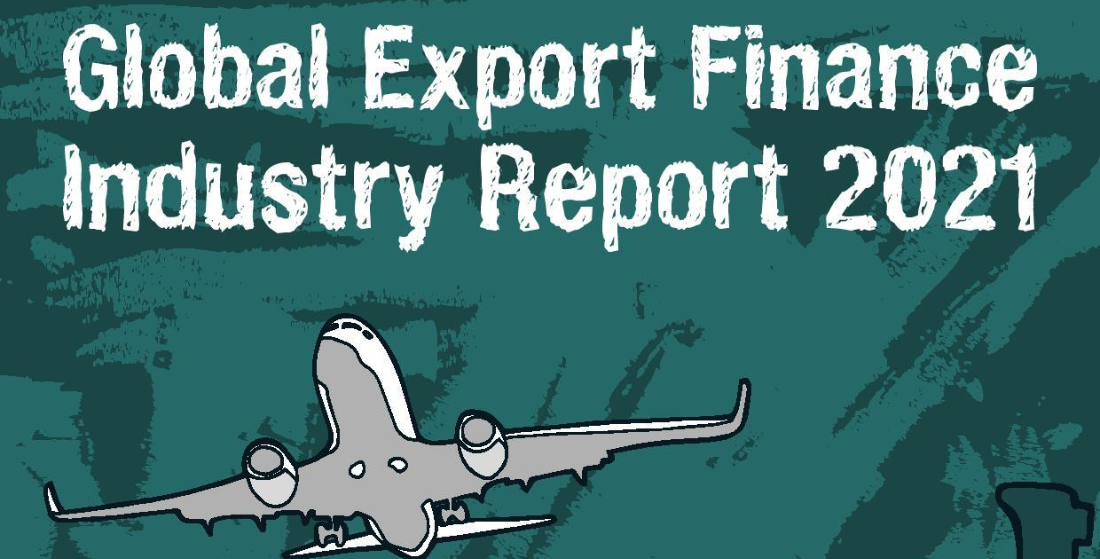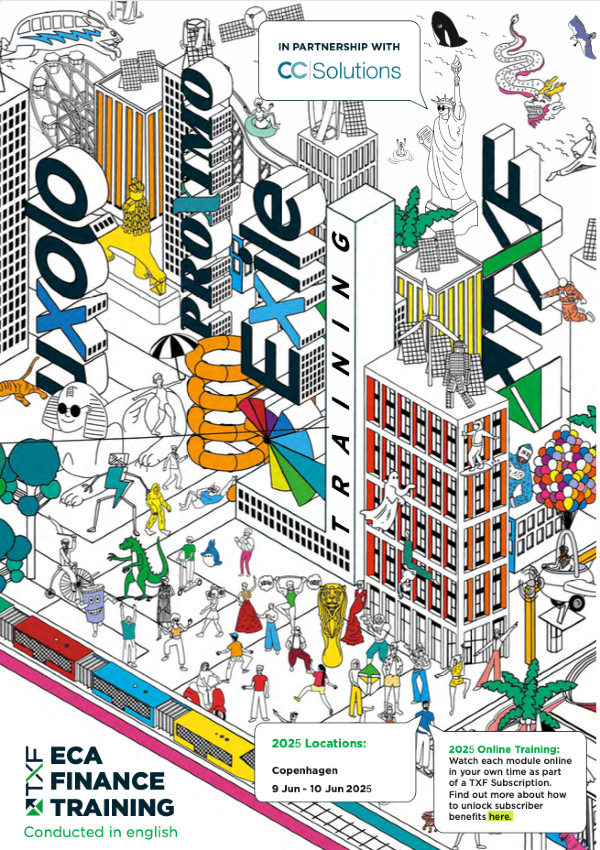Export finance 2021: A look under the hood of the global report
TXF’s 2021 Global Export Finance Industry Report has revealed a series of trends in the export finance industry, largely centered around the drive towards sustainability, and the adaptation of ECA and bank products to suit a growing need for flexibility that has come to light since the start of the pandemic.

While Covid-19 has laid waste to much of the world's economy and has shoehorned its way into almost every facet of our lives, it seems to have left the export finance industry slightly shaken yet largely unscathed.
TXF’s 2021 Global Export Finance Industry Report, including responses from 452 individuals, has revealed a series of trends in the export finance industry, largely centered around the drive towards sustainability, and the adaptation of ECA and bank products to suit a growing need for flexibility that has come to light since the start of the pandemic.
A year of big deals
With the total deal volume of 2020 ($114 billion, excluding Covid-19 relief) surpassing that of 2019 and 2017, the export finance market appears to have beat the pandemic-skewed odds, bolstered by the increasing drive towards sustainability.
While comparisons to previous years indicate relative success, they obfuscate a notable side effect of the pandemic: the global wave of lockdowns, which caused delays and disruptions to supply chains, causing a lack of working capital. So why aren't we seeing the crippling knock-on effects which many other sectors of the economy have experienced?
TXF Data shows that fewer but larger deals may have skewed the data, with just 15 deals accounting for over half of 2020’s deal volume, coming in at $62 billion, the largest of which being the $14.9 billion heavily ECA-backed Mozambique LNG project. While there is no hard evidence to suggest this is a deliberate strategy by banks to release liquidity for the largest deals, it has nevertheless has made its impact felt. If this concentration around the biggest deals continues it could cause serious side effects across the entire industry, not least to SMEs and MMEs involved in smaller deals who may now find it difficult to access liquidity through traditional means.
However, this is not an issue of bank liquidity, explains Gabriel Buck, Managing Director of GKB Ventures. “The data indicates that Banks chase the larger deals because of economies of scale – I don’t see it as an issue of liquidity. Banks are now liquid” said Buck.
“My experience is that banks don’t get involved in the smaller deals as they need to reserve their time and energy to structure and package larger transactions. It takes the same effort to do a large deal as a small one. Thus, the real issue for banks is the systemic risk that they are all chasing fewer and larger transactions – which historically has been in sectors of Oil & Gas, Aviation and Cruise which in today’s market is challenging.”
Buck continues, “The average ticket size of deals closed is circa $350m. The top 14 or 15 transactions closed last year accounted for 50% of the total volumes of ECA deals done globally. That’s not healthy for the industry as a whole”.
Renewable energy and the conformity challenge
It felt like 2020 has been a watershed moment for renewable energy projects, marking the first year where recorded deal volumes for renewable energy exceed that of traditional power projects in a glimpse of what is to come with regards to rapidly growing industry interest in renewable energy. According to TXF Data, approximately 30% of the total deal volume lent in 2020 was for sustainable deals - around twice as much as 2019.
Contributing substantially to these numbers is the $7.3 billion Bpifrance, EKN and GIEK-backed Dogger Bank wind farm being built off the east coast of the UK, poised to be the largest recorded wind project financing to date.
Despite this, the current lack of uniformity across the industry with regards to how sustainable deals are classified and monitored continues to pose an obstacle. It appears that the sheer breadth and depth of the changes required to implement TCFD, not to mention the existence of other multiple different frameworks, clearly breeds hesitancy in those across the industry who may well be sympathetic to its goals.
More than a third of the banking respondents and nearly half of exporters and buyers have no intention to implement TCFD reporting standards at any point in the future.
With approximately one-quarter of ECAs, one-third of banks and buyers, and more than half of exporters reporting having no knowledge of TCFD at all, and only a slim majority not seeing TCFD as a tick box exercise, this educational and implementation lag is likely to exacerbate delays, highlighting remaining hesitancy felt by the industry.
Industry inertia notwithstanding, some are making headway. Banks are leading the charge for TCFD implementation, with just under a third looking to implement TCFD within the next 12 months. Lagging behind are the ECAs, exporters and buyers who are working to a one to three year timescale.
Those aware of TCFD highlighted four main reasons for adoption reluctance; Covid-19, a lack of understanding as to the risks of TCFD integration, the existence of other climate change-related initiatives and a general lack of understanding of TCFD guidelines across the entire company.
Taking into account that in its current format, TCFD appears to be aimed at the largest companies, smaller players in the export finance industry may struggle to scale down the framework.
This is not to say sustainability deals are themselves unattractive. Nine out of 10 (91%) export finance banks reported being willing to provide more attractive financing for any sustainable deal. In fact, renewable energy looks set to be the most invested-in sector over the coming year.
The remainder of 2021 looks set to match a strong 2020 for investments in renewable energy, a year where $16.7 billion worth of volume closed, split across 25 deals. This strong showing is mirrored in infrastructure investment, where $13.3 billion worth of deals closed and notably the £1.7 billion UKEF-backed loan for the Cairo Monorail Project, the largest amount of financing that UKEF has ever backed for an overseas infrastructure project.
Glancing at global performance, Africa recorded the highest total export finance deal volume at $34.5 billion ($3 billion more than Europe), contradicting the notion of the Eurocentric nature of export finance held by respondents. While on paper, Europe looks set to achieve the highest average deal volume of investment over the coming year, Buck is “without a doubt” that Africa will be attracting vast amounts of financing, driven by growing demands for green technology.
“There are 9 countries in Africa who, according to the IMF, will grow over 6% in 2021 (Mauritius, Botswana, Djibouti, Niger, Guinea, Rwanda, Cot D’Ivoire, Chad, the Gambia)” said Buck. “Following Africa then Latin America especially in the mining & metals space. The demand for minerals required for electric vehicles and their associated batteries will increase demand for long term ECA finance”.
Unsurprisingly, banks anticipate large numbers of deals in the oil and gas downstream and midstream, with the renewable energy sector expecting less deals overall but with much greater deal volume.
In the aviation sector, despite pandemic-induced difficulties, over half of banks plan to continue investing in aviation as normal. However, qualitative data shows that investment will be determined on a case-by-case basis, with ECAs playing a large role. Shipping on the other hand will be facing a difficult year ahead, with 51% of banks partially pulling back or completely moving away from shipping for the foreseeable future. While the cruise ship industry is in dire straits with no planned new builds on the horizon, the outlook appears a little brighter for container shipping, where green facilities are being provided for new ships.
Despite the ongoing effects of the pandemic, the debt picture for banks looks strong, with the vast majority of banks being able to fund for the full tenors and 75% of banking respondents confident that they will be able to generate healthy margins above the cost of debt.
As to whether the cost of debt will increase or decrease “I’m going to stay on the fence and say “it will remain the same” says Buck. “This is very hard to predict especially as there is a lot of price difference between banks and the way they price ECA assets, [With] big spread between the highest and lowest. My sense is that the market will find its balance during 2021 in a similar manner to pricing as seen in the end of 2020”.
Another side effect of Covid-19 has been the rapid adoption of remote working, with many banking respondents indicating some difficulties with training new staff, and originating & closing new deals. Overall, the general feeling is that trust-based relationships cannot be replicated virtually, and working from home is not a long term solution for export finance.
Cautious optimism for ECAs
Looking to ECAs, the general mood seems to be one of cautious optimism despite the pandemic, with a focus on counterparty risk, increased short term liquidity, direct lending facilities, and a reduction in red tape to speed up processes.
More than 80% of the ECAs surveyed have seen an increase in the level of deal restructurings they have been involved in over the past 12 months, with the largest of these deals thus far being the heavily ECA backed $8.2 billion Ichthys LNG refinancing.
Just over 40% of the ECAs surveyed noted that they do have flexibility to access the CIRR with unlimited capacity and 30% noted that they intend to increase the level of direct lending on offer to their clients.
“I would expect a buoyant ECA market.” adds Buck. “Many of the factors that make ECA financing so attractive will remain. My concern will be for those banks who have historically focused on the larger Oil & Gas, Aviation and Cruise ship sector – with these sectors struggling can they find enough deals to fill the gap. Hopefully yes and they can adapt quickly”.
Exporters and buyers
Within the exporter and buyer sector, nearly two-thirds of the total sample have noted that they are not prepared to pay more for green financial products. For those willing to pay a higher price, the minimum reduction they would expect to see from the banks is 17.3 basis points.
There remains a substantive gap, currently to the tune of around 10 basis points, in the average reduction in price that exporters and buyers expect the prices banks are currently willing to consider.
Top performing banks and ECAs
French banks, starting with Credit Agricole CIB, dominated as the top rated bank for export finance, followed by BNP Paribas and Societe Generale.
Product offering has remained the dominant attribute considered when choosing an export finance bank, yet presents a significant area in need of improvement for all banks.
Moving away from survey data and onto TXF’s own data, limited to bank activity and deal volume only, the top-rated bank over the past 12 months was Intesa Sanpaolo, with a total deal volume of $7.1 billion across 5 deals. The top performing ECA was the South Korean Export Import Bank, KEXIM.
Particularly during times of stress, the report has shown that for both banks and ECAs, an understanding of client business needs, industry expertise, and customer service are vital.
While some uncertainty remains due to Covid-19, many report being in a relatively healthy and profitable position moving forward. Barring further unprecedented blockages to global trade, 2021 looks set to be another strong year for export finance.
Find out how you can purchase the full report by emailing intelligence@txfmedia.com today or download the free redacted version of the report for a sneak peak here





